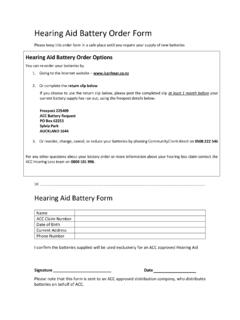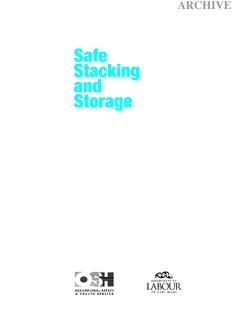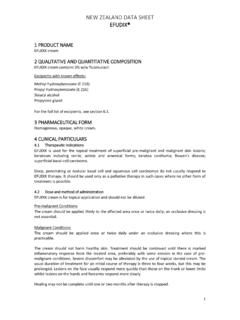Transcription of Accredited Employers Programme
1 Accredited Employers ProgrammeAudit Standards Effective from 1 April 2017 What s new?The Accredited Employers Programme (AEP) audit standards have been updated and are effective from 1 April 2017. They replace the audit standards released by ACC in 1 April read this book carefully. It has been reviewed and updated to: Clarify common areas of misunderstanding or misinterpretation by Employers Assist with more consistent implementation of the standards Incorporate recent legislative changes and developments in best practice Remain aligned to the direction of the changes to the health and safety legislation Assist in the performance of monitoring claims and rehabilitation * Please refer to the definitions on pages 50 to 59 if you require further with the safety Management Practices Audit Standards set out in this document should not be relied on to satisfy compliance with legal and other obligations of the employer.
2 It is the responsibility of the individual employer to be satisfied that these legal and other obligations are : there are other specific duties required of the employer, and/or a Person Conducting a Business or Undertaking (PCBU)*, under the terms of the Health and safety at Work Act 2015 (HSWA) that are not part of this Programme s Standards for ACC Accredited Employers Programme 2 What do the audit standards do? 2 What do the audit standards comprise? 2 What are the three levels of performance? 2 What do the levels mean? 3 What does the audit involve? 3 What is the process to gain initial entry to the AEP? 5 What is the process to maintain AEP membership? 6 safety management practices requirements 7 Injury management practices requirements 25 Focus group interviews and selected case studies 42 Definitions 49* Please refer to the definitions on pages 50 to 59 if you require further Standards for ACC Accredited Employers ProgrammeThe audit standards for the AEP are designed to: Help Employers to create safer workplaces Establish.
3 A minimum acceptable benchmark for health and safety and injury management in the workplace the expectation of continuous improvement of workplace health and safety systems towards successful integration of good practice standards in all areas and developing the audit standards, the spirit and intent of relevant legislation was considered (including the Accident Compensation Act 2001 (The Act), and the Health and safety at Work Act 2015 (HSWA).The audit standards are aligned to AS/NZS 4801:2001, the joint Australia/ new zealand Standard for Occupational Health and safety Management do the audit standards do?Use of the AEP audit standards enables ACC to determine, under the Framework for Accredited Employers Programme 2000 (The Framework) and The Act, an employer s ability to meet either the entry level or the annual continuance requirements of the audit provides a snapshot of the ability of the organisation to meet the requirements of the AEP.)
4 Therefore, it is the ongoing responsibility of the employer to monitor and evaluate injury prevention and injury management performance in the workplace, to ensure that the minimum entry-level audit standards are at least maintained, and hopefully exceeded. This is in line with the AEP s expectation of continuous improvement in workplace health and safety systems towards successful integration of good practice audit standards in all areas and audit standards will be subject to a regular review process to maintain alignment to international good practice health and safety standards, and to ensure they are adapted to the new zealand legislative and workplace do the audit standards comprise?The audit standards are divided into three main parts: Elements one to nine that cover safety management practices including workplace observation Elements 10 to 17 covering injury management, including claims administration and rehabilitation Elements 18 to 20 include focus group interviews with management and employees and selected case studies to confirm safe systems in are the three levels of performance?
5 Within the audit standards there are three measurable levels of performance: Primary Secondary TertiaryWithin the audit standards these different levels of performance are demonstrated by using shading as indicated * Please refer to the definitions on pages 50 to 59 if you require further clarification.* Please refer to the definitions on pages 50 to 59 if you require further 2 Planning, review and evaluation(AS/NZS 4801:2001 Sections , and )ObjectiveThe employer is able to demonstrate a systematic approach to occupational health and safety that includes a focus on continuous improvement. This involves setting objectives, developing plans and programmes to achieve objectives, regular review of progress, and evaluation of of requirementsVerified byAchievedYes/No1.
6 The employer is able to demonstrate knowledge of current health and safety information including legislation, regulations, safe work instruments (SWI)*, codes of practice (CoP)*, standards and specialist information relevant to the work that is Procedure/s* that explain how the employer will identify relevant legislation, SWI, CoP, standards, guidelines and other industry information. Timeframes for checking, reviews and responsibilities are Procedure/s are in place to ensure compliance or conformance with relevant Evidence that the employer has reviewed relevant information within the last 24 months and, where appropriate, made There is a system in place to ensure the effectiveness of health and safety management for the organisation is reviewed regularly and after a notifiable event*.
7 1. Procedure/s that explain how the effectiveness of organisational health and safety management will be Evidence that the effectiveness of health and safety management has been reviewed in the last 12 Procedure/s to review health and safety management that occurs after: a notifiable event changes in work procedures changes in health and safety policies and Health and safety objectives are set that are: appropriate to the size and type of business or undertaking relevant to each level within the business or undertaking related to identified hazards* and risks*.1. Evidence of health and safety objectives and plans to achieve Procedure/s to review and update or reset health and safety objectives at least every 12 Evidence that health and safety objectives have been reviewed, updated or reset in accordance with the Evidence that senior management and employees, or employee or union representatives, have been included in the review and setting of.
8 53744-ACC440-AEP Audit Standards March 2021 953744-ACC440-AEP Audit Standards March 2021 95/03/21 10:31 AM5/03/21 10:31 AMPrimary Programme entry level requirementsSecondary consolidation of good practiceTertiary continuous improvement, good practice framework It is important to note that achieving the audit standards should not be relied on to satisfy compliance with the HSWA, other legislation or other obligations you may have as an employer. To learn more about the HSWA and your obligations, please visit the WorkSafe NZ website do the levels mean?To gain entry to the AEP, Employers need to meet all the primary level requirements (or demonstrate similar but equivalent verification of the requirements).These standards must then be maintained in subsequent annual audits to remain in the is an expectation that an employer meeting only the primary entry-level requirements for health and safety and injury management will demonstrate either: Further consolidation of these audit standards into all areas of the workplace; or Progression through the secondary and tertiary levels in successive annual progress towards raising the level of workplace health and safety would provide evidence of commitment to continuous does the audit involve?
9 Each prospective Accredited Employer is asked to read the audit standards thoroughly and undertake a self- assessment, to determine whether entry level audit standards can be met, before proceeding to an application and independent list of independent occupational health and safety auditors and the locations they cover is available on the ACC website at: audit is made up of the following phases:1. Viewing all relevant systems and process documents required by the audit Visiting selected site/s to view evidence of health and safety systems in practice, and local site Management and employee focus group interviews and case study interviews to confirm safe systems in Writing of the audit report according to a set format and forwarding to ACC for a final decision on the audit auditor will be asked by ACC to visit a site (or sites) representative of each main function of the employer s business operations.
10 For example, where business operations are totally office-based, one site only will be the functions of a business include office, factory and retail operations, one of each of these sites will be visited as part of the is envisaged the audit will take no longer than two days for a single site employer with only one major business operation. For larger organisations the audit may take longer depending on the size, number and spread of locations and operational variety within the organisation. This duration estimate is a guide only, to give Employers some idea of the time that may be * Please refer to the definitions on pages 50 to 59 if you require further selection of the site or sites to be audited will usually be rotated by ACC in subsequent annual audits to build up a more complete picture of the workplace year by management focus group interview for each audit and one employee focus group for each site visited will be undertaken to confirm the understanding of employer and employee responsibilities for workplace health and there are lost time injuries, ACC will also select up to five case studies to be looked at in detail to confirm the management of the injury, the administration of the claim.















